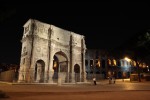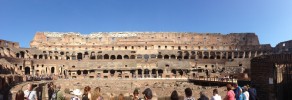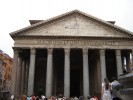Ancient Sites Photo Gallery
|
|
|

Italy, Pompeii - villa This is one of the more fashionable villas in town. Note the private garden area to the rear. The small pool in the foreground was for catching rainwater falling through a specially made hole in the roof. July 2008Mark Z
|
|

Italy, Pompeii - villa of MeneanderJ. B.
|
|

Italy, Pompeii, July 2008A picture high up on the wall of the brothel, depicting what the paying customer could expect in the room beneath it.Mark Z
|
|

Italy, PopuloniaEtruscan grave
|
|

Italy, PopuloniaEtruscan grave
|
|

Italy, Populonia - Etruscian necropoleThis Etruscian necropole is near the town Piombino in the Toscana Italy, this graves are from the 3-2 century before christ.
|
|

Italy, Populonia - Content of an etruscian grave In the museum of Piombino there is a Replica of an grave of the Populonia necropole, with the original content of this grave.
|
|

Italy, Populonia - mosaicThis mosaic was found already in the early 19 th century, it shows many sea animals and a ship wreck.
|
|

Italy, Populonia - mosaic, nearly total viewA famous beautiful mosaic with a ship wreck and many different sea animals, fishes, octopus snail etc.; most animals can be identified. Now in the museum of Piombino
|
|

Italy, Populonia - necropole2nd century BC - etruscian necropole, the content of all graves is robbed before the scientist could explore those, except the one at the bottom. the content of this grave could now be seen in the museum of piombino.
|
|

Italy, Port facilities of SybarisExcavated remains of the port facilities of Sybaris. These are located on the Casa Bianca site in the easternmost section of the Sybaris archaeological park. http://en.wikipedia.org/wiki/File:Sybaris_port_facilities.jpgJoe Sermarini
|
|

Italy, Ravenna, Mausoleum of Galla Placidiait is describbed as "the earliest and best preserved of all mosaic monuments, and at the same time one of the most artistically perfect"
The building was formerly the oratory of the Church of the Holy Cross and now contains three sarcophagi. The largest sarcophagus was thought to contain the remains of Galla Placidia (died 450). Other is attributed to her husband, Emperor Constantius III. The last sarcophagus is attributed to Galla's son, Emperor Valentinian III, or to her brother, Emperor Honorius.J. B.
|
|

Italy, Ravenna, Mausoleum of Galla Placidiait is describbed as "the earliest and best preserved of all mosaic monuments, and at the same time one of the most artistically perfect"
The building was formerly the oratory of the Church of the Holy Cross and now contains three sarcophagi. The largest sarcophagus was thought to contain the remains of Galla Placidia (died 450). Other is attributed to her husband, Emperor Constantius III. The last sarcophagus is attributed to Galla's son, Emperor Valentinian III, or to her brother, Emperor Honorius.J. B.
|
|

Italy, Ravenna, Mausoleum of Galla Placidiait is describbed as "the earliest and best preserved of all mosaic monuments, and at the same time one of the most artistically perfect"
The building was formerly the oratory of the Church of the Holy Cross and now contains three sarcophagi. The largest sarcophagus was thought to contain the remains of Galla Placidia (died 450). Other is attributed to her husband, Emperor Constantius III. The last sarcophagus is attributed to Galla's son, Emperor Valentinian III, or to her brother, Emperor Honorius.J. B.
|
|

Italy, Ravenna, Mausoleum of Galla PlacidiaThe building was formerly the oratory of the Church of the Holy Cross and now contains three sarcophagi. The largest sarcophagus was thought to contain the remains of Galla Placidia (died 450). Other is attributed to her husband, Emperor Constantius III. The last sarcophagus is attributed to Galla's son, Emperor Valentinian III, or to her brother, Emperor Honorius.J. B.
|
|

Italy, Rome, Appio-Claudian Aqueduct 1Posted by Strength And Honour.
Photo taken by my friend Hebe.
|
|

Italy, Rome, Appio-Claudian Aqueduct 2Posted by Strength And Honour.
Photo taken by my friend Hebe.
|
|

Italy, Rome, Aqua Claudia (aquaduct)entrance to San Stefano RotondoJ. B.
|
|

Italy, Rome, Aqua Claudia, Part of the aquaduct near Basilica of St. John LateranJ. B.
|
|

Italy, Rome, Ara PacisIt was built to honor the triumphal return of the Roman emperor Augustus.
It was consecrated on 30 January 9 BC.J. B.
|
|

Italy, Rome, Arch of ConstantineView of the arch of Constantine from the top of the ColosseumJay GT4
|
|

Italy, Rome, Arch of Constantinecommemorate Constantine I's victory over Maxentius
built in 315
inscription:
IMP · CAES · FL · CONSTANTINO · MAXIMO · P · F · AVGUSTO · S · P · Q · R · QVOD · INSTINCTV · DIVINITATIS · MENTIS · MAGNITVDINE · CVM · EXERCITV · SVO · TAM · DE · TYRANNO · QVAM · DE · OMNI · EIVS · FACTIONE · VNO · TEMPORE · IVSTIS · REM-PVBLICAM · VLTVS · EST · ARMIS · ARCVM · TRIVMPHIS · INSIGNEM · DICAVIT
J. B.
|
|

Italy, Rome, Arch of ConstantineThis is the Triumphal Arch of Constantine in Rome. Erected in 315 AD, it was one of the last monumental buildings erected before the capitol was moved to Constantinople and is still impressive today. It commemorates Constantine's victory over Maxentius at the Battle of Milvian Bridge in AD 312.
It is thought much of the sculptural decoration consists of reliefs and statues removed from earlier triumphal monuments dedicated to Trajan (98–117), Hadrian (117–138) and Marcus Aurelius (161–180).Ron C2
|
|

Italy, Rome, Arch of ConstantineThis is the Triumphal Arch of Constantine in Rome. Erected in 315 AD, it was one of the last monumental buildings erected before the capitol was moved to Constantinople and is still impressive today. It commemorates Constantine's victory over Maxentius at the Battle of Milvian Bridge in AD 312.
It is thought much of the sculptural decoration consists of reliefs and statues removed from earlier triumphal monuments dedicated to Trajan (98–117), Hadrian (117–138) and Marcus Aurelius (161–180).Ron C2
|
|

Italy, Rome, Arch of Constantine with Colosseum in the backgroundJ. B.
|
|

Italy, Rome, Arch of Dolabella(the Porta Caelimontana)
built by consul Publius Cornelius Dolabella in 10 AD.
It was part of Aqua Marcia and later Aqua Claudia leading to Palatin.J. B.
|
|

Italy, Rome, Arch of Septimius Severusbuilt in 203 AD to commemorate the Parthian victoriesJ. B.
|
|

Italy, Rome, Arch of Septimius SeverusThe Arch of Septimius Severus was erected in 203 A.D. to commemorate the Parthian victories of Septimius Severus and his sons Caracalla and Geta in their campaigns against the Parthians of 194-195 A.D. and 197–199 A.D.
Interestingly, Caracalla invoked damnatio memoriae on Geta after he had his younger brother killed and Geta's name was removed from the Arch, though it's still faintly visible today. Ron C2
|
|

Italy, Rome, Arch of Septimus SeverusPosted by Strength And Honour.
Photo taken by my friend Hebe.
|
|

Italy, Rome, Arch of TitusArch of Titus in Rome depicting the spoils of Jerusalem's temple.
Photo taken September 2005Jay GT4
|
|

Italy, Rome, Arch of Titusbuilt by Domitianus
commemorate victory of Titus in Jerusalem in the first Jewish–Roman WarJ. B.
|
|

Italy, Rome, Arch of TitusThe Arch of Titus, on the Via Sacra, Rome, just to the south-east of the Roman Forum, was completed by Domitian in 96 A.D. to commemorate Titus' victories, including the Siege of Jerusalem in 70 A.D. The Arch of Titus has provided the general model for many of the triumphal arches erected since the 16th century—perhaps most famously it is the inspiration for the 1806 Arc de Triomphe in Paris, France, completed in 1836.J. B.
|
|

Italy, Rome, Arch of TitusThe Arch of Titus was erected in 81 AD by Domitian shortly after the death of Titus to commemorate his consecratio and the victory of Titus together with their father, Vespasian, over the Jewish rebellion in Judaea.
The Arch if notable for the menorah depicted on the arch, one of the best period depictions of the artifact from the Jewish temple. Ron C2
|
|

Italy, Rome, Basilica of Santi Cosma e Damiano, Roman bronze doorsThe original bronze doors of the Temple of Divus Romulus still survive and are pictured above. They are set between two porphyry columns that support a reused marble architrave and open into a rotunda fifty Roman feet in diameter covered by a cupola which is accessible from the rear through the Basilica of Santi Cosma e Damiano. The temple was converted into a vestibule for the church early in the 6th century.*Alex
|
|

Italy, Rome, Basilica Ulpia and Trajan's columnChurch of the Most Holy Name of Mary at the Trajan Forum in the background.J. B.
|
|

Italy, Rome, Baths of Caracallabuilt between 212 AD and 216 AD
http://en.wikipedia.org/wiki/Baths_of_CaracallaJ. B.
|
|

Italy, Rome, Baths of Caracallahttp://en.wikipedia.org/wiki/Baths_of_CaracallaJ. B.
|
|

Italy, Rome, Baths of Caracallahttp://en.wikipedia.org/wiki/Baths_of_CaracallaJ. B.
|
|

Italy, Rome, Capitoline Museums, Capitoline VenusCapitoline museumsJ. B.
|
|

Italy, Rome, Capitoline Museums, DianaCapitoline museumsJ. B.
|
|

Italy, Rome, Capitoline Museums, Esquiline VenusCapitoline museumsJ. B.
|
|

Italy, Rome, Circus Maximus600m x 200m
+- 320000 spectators
last race in 549 ADJ. B.
|
|
|
|

Italy, Rome, Colosseumbuilt between 70 AD and 80 ADJ. B.
|
|

Italy, Rome, Colosseum50000 spectators
It has been estimated that about 500000 people and over a million wild animals died in the Colosseum games.J. B.
|
|

Italy, Rome, ColosseumJ. B.
|
|

Italy, Rome, ColosseumJ. B.
|
|

Italy, Rome, ColosseumJ. B.
|
|

Italy, Rome, Colosseumhall inside colloseumJ. B.
|
|

Italy, Rome, ColosseumJ. B.
|
|

Italy, Rome, Colosseum 1Posted by Strength And Honour.
Photo taken by my friend Hebe.
|
|

Italy, Rome, Colosseum 2Posted by Strength And Honour.
Photo taken by my friend Hebe.
|
|

Italy, Rome, Colosseum 3Posted by Strength And Honour.
Photo taken by my friend Hebe.
|
|

Italy, Rome, Colosseum 4Posted by Strength And Honour.
Photo taken by my friend Hebe.
|
|

Italy, Rome, Colosseum Arch of ConstantineOne of my favorite photos I took in Rome, a view of the Arch of Constantine as seen looking out from inside the Colosseum. fordicus
|
|

Italy, Rome, Colosseum with arch of Constantine in the backgroundJ. B.
|
|

Italy, Rome, Colosseum, Flavian AmphitheatreHere's yet another pic of the famous Roman landmark, only this time, I used the "Pano" feature on my iPhone, allowing the entire northern half to be viewed. Mark Z
|
|
![Filename=IMG_0728[1].JPG
Filesize=122KiB
Dimensions=640x480
Date added=Jun 23, 2011 IMG_0728[1].JPG](albums/userpics/28795/thumb_IMG_0728%5B1%5D.JPG)
Italy, Rome, Colosseum, Inside -- May, 2011pitbull
|
|

Italy, Rome, Column of Antoninus Pius, Cortile della Pigna, Vatican MuseumsAbove are the four sides of the base of the Column of Antoninus Pius (Columna Antonini Pii) which was erected in the Campus Martius in memory of Antoninus Pius by Marcus Aurelius and Lucius Verus c.A.D.158 on the twentieth anniversary of his reign. Constructed of red granite, the column was 14.75 metres high and 1.90m in diameter, unlike the otherwise similar column of Trajan it had no decorating reliefs. The masons' inscription shows that it was quarried out in A.D.106 and architecturally it belonged to the Ustrinum which was 25m north of it on the same orientation. It was surmounted by a statue of Antoninus Pius. Previous to the 18th century the base was completely buried, but the lower part of the shaft projected about 6m above the ground. In 1703, when some buildings were demolished in the area of Montecitorio, the rest of the column and the base were discovered and excavated. The base still survives and is now housed in the Cortile della Pigna in the Vatican Museums.*Alex
|
|

Italy, Rome, Column of Marcus AureliusIt was built in 176 or later after death of Marcus Aurelius to celebrate victory over Marcomani and Quadi and Sarmatians. J. B.
|
|

Italy, Rome, CuriaThe place where the Senate held its meetings.
Notice the three different kinds of marble used for the pavement. The beheaded statue should be Trajan's.
Posted by Strength And Honour.
Photo taken by my friend Hebe.
|
|

Italy, Rome, Curia Iulia, Forum RomanumCuria Julia (Latin: Curia Iulia, Italian: Curia Iulia) is the third named Curia, or Senate House, in the ancient city of Rome. It was built in 44 BC when Julius Caesar replaced Faustus Cornelius Sulla’s reconstructed Curia Cornelia, which itself had replaced the Curia Hostilia. Caesar did this in order to redesign both spaces within the Comitium and Forum Romanum. The alterations within the Comitium reduced the prominence of the senate and cleared the original space. The work, however, was interrupted by Caesar's assassination at the Theatre of Pompey where the Senate had been meeting temporarily while the work was completed. The project was eventually finished by Caesar’s successor Augustus in 29 BC. The Curia Julia is one of only a handful of Roman structures to survive to the modern day mostly intact, due to its conversion into the basilica of Sant'Adriano al Foro in the 7th century and several later restorations. However the roof, together with the upper elevations of the side walls and rear façade, are modern. These parts date from the remodeling of the deconsecrated church in the 1930s.Joe Sermarini
|
|

Italy, Rome, Domitian's stadium on PalatinJ. B.
|
|

Italy, Rome, Flavian Palace - Domus Flavia (and Circo Massimo)The Flavian Palace, also known as Domus Flavia, is a part of the vast residential complex of the Roman Emperors on the Palatine Hill in Rome. It was completed in 92 AD in the reign of Titus Flavius Domitianus, more commonly known as the Emperor Domitian, and attributed to his master architect, Rabirius. Well known for its grandeur, the Flavian Palace was more commonly used for purposes of state, while the Domus Augustana, an enormous, lavishly ornamented palace south of the Flavian Palace, was the Emperor’s primary residence.
Source: http://en.wikipedia.org/wiki/Flavian_Palace
by Doug ColdwellJoe Sermarini
|
|

Italy, Rome, ForumView down onto the Roman forum. Palatine hill is in the background. Photo taken in 2005.Jay GT4
|
|

Italy, Rome, Forum1999
I think this is ( or near) The Forum - Temple of SaturnRandygeki(h2)
|
|

Italy, Rome, Forumruins of The Forum - Temple of Saturn being excavated 1999
We were unable to get close, I think this pic was taken from the sidewalk by hte main road that ran by.Randygeki(h2)
|
|
|

Italy, Rome, Forum from PalatinoTemple of Antoninus and Faustina
Temple of Romulus
This temple Maxentius built for his son Romulus who died 309 AD. Maybe the temple is built over earlier temple.
In 527 the temle with library on Vespasian's forum was rebuild to church of St. Cosma and Damian.J. B.
|
|

Italy, Rome, Forum of AugustusIt includes the Temple of Mars UltorJ. B.
|
|
![Filename=IMG_0690[1].JPG
Filesize=123KiB
Dimensions=640x480
Date added=Jun 23, 2011 IMG_0690[1].JPG](albums/userpics/28795/thumb_IMG_0690%5B1%5D.JPG)
Italy, Rome, Forum, arch of Septimius Severus and Curiapitbull
|
|

Italy, Rome, Ludus Magnus GladiatorumPosted by Strength And Honour.
Photo taken by my friend Hebe.
|
|

Italy, Rome, Mausoleum of AugustusPosted by Strength And Honour.
Photo taken by my friend Hebe.
|
|

Italy, Rome, Mausoleum of Hadrian and Pons Aeliusbuilt between 135 AD and 139 AD
bridge was built in 134 AD
Hadrian and Sabina,
Antoninus Pius and Faustina,
Lucius Verus,
Marcus Aurelius,
Commodus,
Septimius Severus and
Caracalla were buried here.J. B.
|
|

Italy, Rome, National Museum of Rome, Suicide of a Gaul Pallazo Altemps
Roman copy of Hellenistic original 230-220 BC, one of the bronze groups commissioned from Greek sculptors by Pergamon king Attalus I after his recent victories over the Gauls of Galatia.J. B.
|
|

Italy, Rome, Original ancient door from Curianow it is in Basilica of St. John Lateran ... seat of Pope until he moved to VaticanJ. B.
|
|

Italy, Rome, Palace of Domitianon PalatinJ. B.
|
|

Italy, Rome, Palazzo Massimo alle Terme - DiscobolosPalazzo Massimo alle TermeJ. B.
|
|

Italy, Rome, Palazzo Massimo alle Terme, HermaphroditePalazzo Massimo alle TermeJ. B.
|
|

Italy, Rome, Palazzo Massimo alle Terme, sarcophagus Palazzo Massimo alle Terme
there is also great collection of roman coins.J. B.
|
|

Italy, Rome, PantheonM AGRIPPA COS TERTIVM FECIT
The original Pantheon was built by Marcus Agrippa and later restored and rebuilt by Hadrian added and engineered the worlds largest unsupported domed roof. He kept the original dedication to Agrippa. A marvel of engineering and a sight to see.Jay GT4
|
|

Italy, Rome, Pantheonbuilt by Agrippa 27 BC
rebuilt by Hadrian into present shape in 123 AD
remains of Neptune's basilicaJ. B.
|
|

Italy, Rome, Pantheonbuilt by Agrippa 27 BC
rebuilt by Hadrian into present shape in 123 AD
M AGRIPPA L F COS TERTIVM FECIT
In 609 panteon was converted into church of St. Mary and the Martyrs.J. B.
|
|

Italy, Rome, PantheonJ. B.
|
|

Italy, Rome, Pantheon insideInterior view of Hadrian's dome and ocular center. An engeneering masterpiece, the concrete gets thinner as it rises. The open ocular in the center allows light to flood into this massive ancient space. The walls at the bottom are about 12 feet thick. The interior is completely ancient from the marble floors to the walls and dome. Origianlly dedicated to all the god's it is now a Catholic church.Jay GT4
|
|

Italy, Rome, Pons Aemiliusthe oldest stone-bridge in Rome
bridge with six wholly stone arches was comleted in 142 BC
bridge was destroyd in 1598 AD by flood.
http://en.wikipedia.org/wiki/Pons_AemiliusJ. B.
|
|

Italy, Rome, Pons FabriciusOldest bridge in Rome - built in 62 BC and still existing in its original state.J. B.
|
|

Italy, Rome, Porta Asinariagate in the Aurelian Walls built 270-273 AD
(near San Giovanni in Laterano)J. B.
|
|

Italy, Rome, Porta San Giovannigate in the Aurelian Wall
gate was built for pope Gregory XIII
(near San Giovanni in Laterano)J. B.
|
|

Italy, Rome, Porta San Paologate in Aurelian wallsJ. B.
|
|
|
|
